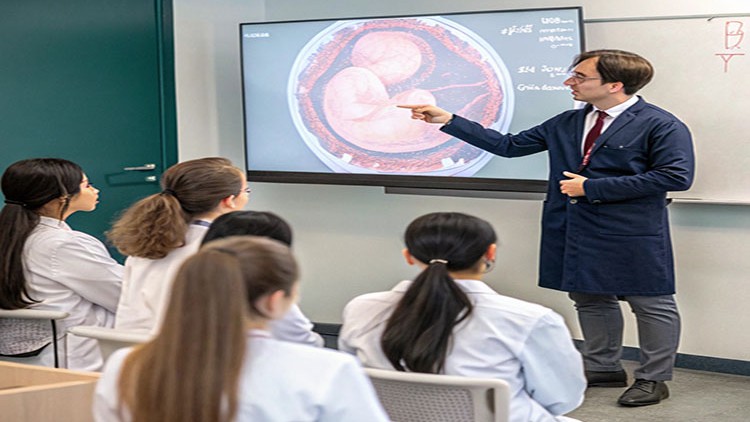Clinical Embryology: A Practical Approach

- Description
- Curriculum
- FAQ
- Reviews
Embark on a fascinating journey through the wonders of human embryology! This course explores the remarkable process of how a single cell transforms into a complex human being. We will cover key developmental stages, cellular differentiation, organogenesis, and the impact of genetic and environmental factors on prenatal development. The course is ideal for students seeking a solid foundation in human embryology.
This comprehensive course delves into the intricate process of human development, from fertilization to birth. Through a blend of theoretical and practical approaches, students will gain a deep understanding of the key events, cellular and molecular mechanisms, and clinical implications of embryology. The course is designed for students in all health fields, including medical, nursing, and allied health professions, as well as healthcare professionals seeking to enhance their knowledge of human development.
potential Course Topics:
-
Gametogenesis: Sperm and oocyte formation
-
Fertilization and Early Embryonic Development: Cleavage, implantation, gastrulation
-
Organogenesis: Development of major organ systems (e.g., cardiovascular, nervous, musculoskeletal)
-
Fetal Development: Growth, maturation, and placental function
-
Teratology: Congenital anomalies and their causes
-
Clinical Embryology: Prenatal diagnosis, assisted reproductive technologies
-
Molecular and Cellular Mechanisms of Development: Gene expression, signaling pathways, stem cells
-
this course for students and professionals in the healthcare field who need to learn or review human embryology. It effectively combines scientific information with clinical applications, making it relevant and engaging for learners.
-
1embryology introductionVideo lesson
-
2why we as medical students and medical professionals study embryologyVideo lesson
-
3history of embryologyVideo lesson
-
4clinical aspect of embryology lect1Video lesson
-
5clinical aspect of embryology invitro fertilization foetusl imagingVideo lesson
-
6clinical aspect of embryology Embryology and GeneticsVideo lesson
-
7clinical aspect of embryology organ symphonyVideo lesson
-
17gastrulationVideo lesson
-
18gastrulationVideo lesson
Gastrulation is a crucial phase in embryonic development when a single-layered blastula reorganizes into a multi-layered structure called the gastrula. This process establishes the three primary germ layers—ectoderm, mesoderm, and endoderm—which later give rise to all tissues and organs in the body. Here's how it works:
1. Key Features of Gastrulation
Formation of Germ Layers:
Ectoderm (outer layer): Becomes the skin, nervous system, and sensory organs.
Mesoderm (middle layer): Develops into muscles, bones, circulatory system, and internal organs.
Endoderm (inner layer): Forms the lining of the digestive tract, lungs, and other internal structures.
Development of the Primitive Streak:
In amniotes (like humans), gastrulation begins with the formation of the primitive streak, a structure that establishes the body's bilateral symmetry.
Cells migrate through this streak to form the different germ layers.
2. Stages of Gastrulation
Initiation: The blastula (a hollow sphere of cells) begins to invaginate (fold inward) at a specific location, creating the blastopore, which eventually becomes the anus in deuterostomes (including humans).
Cell Migration and Differentiation:
Cells move inward through the primitive streak, differentiating into the three germ layers.
The ectoderm remains on the outside, while the mesoderm spreads between the ectoderm and endoderm.
Formation of the Archenteron:
The invagination forms a new cavity called the archenteron, which becomes the primitive gut.
Establishment of Body Axes:
Gastrulation sets up the anterior-posterior, dorsal-ventral, and left-right axes of the body.
3. Importance of Gastrulation
Establishes the basic body plan and organizes cells into their future tissue and organ systems.
It is a highly coordinated process influenced by signaling molecules and gene expression.
-
19polycystic ovaryVideo lesson
-
20case 2 complex caseVideo lesson
-
21Please Say No to alcohol during pregnancyVideo lesson
-
22clinical consideration human gonadotropinVideo lesson
-
23folic acid is the superhero of pregnancyVideo lesson
-
24folic acid and sarahVideo lesson
-
25Risk of pregnancy for old womenVideo lesson
-
26spina bifidaVideo lesson
-
27Myths vs facts folic acidVideo lesson
-
28cleft palateVideo lesson
-
29miscarriage in early pregnancyVideo lesson
-
30AbortionVideo lesson

External Links May Contain Affiliate Links read more




